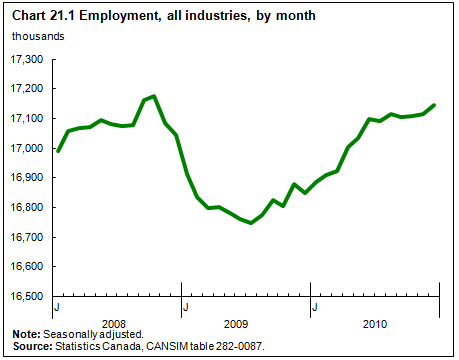Labour
Archived Content
Information identified as archived is provided for reference, research or recordkeeping purposes. It is not subject to the Government of Canada Web Standards and has not been altered or updated since it was archived. Please "contact us" to request a format other than those available.
Related information
The Canadian labour market recovered relatively quickly from the 2008–2009 recession. During the downturn, unemployment reached 8.7% and the number of people employed fell by more than 400,000 in the 9 months following October 2008.
By January 2011—27 months after employment last peaked in October 2008—employment had regained all of the lost ground and unemployment had declined to 7.8%. By comparison, the labour market took much longer to recover from the recessions in the early 1980s and early 1990s—40 months and 53 months, respectively.
Employment growth
Employment increased by 298,000 (1.8%) in 2010, mostly in the first half of the year. This was the largest increase since 2007. This increase followed a 1.2% decrease in employment in 2009.
The job growth was in both full-time (215,000) and part-time (83,000) work; however, part-time grew at a faster pace (2.6% versus 1.6%). This contrasts with 2009, when full-time employment declined by 1.5% and part-time employment increased by 0.2%. With more people working full time in 2010, the number of hours worked rose 1.9%, after having declined 0.8% the year before.
Older workers experienced the fastest employment growth in 2010. Employment among workers aged 55 and older increased 6.4% (180,000), with strong employment growth seen among both older men (6.0%) and older women (6.8%). Employment grew by 0.8% for both core-age workers (aged 25 to 54) and youths (aged 15 to 24). For core-age workers, all the employment growth occurred among men (2.0%).
In the downturn, younger workers, men and individuals with less education experienced disproportionate job losses.
Where the jobs are
Most of 2010's employment growth was in the private sector, where the increase numbered 297,000 employees, up 2.8%. Employment in the public sector increased by 109,000 workers, up 3.1%. The number of self-employed workers, however, fell by 108,000 workers, a drop of 3.9%. In 2009, self-employment grew by 85,000 and the number of private-sector employees fell by 293,000. There was little change in the public sector.
Manufacturing dominated employment growth at year-end. In December 2010, employment in manufacturing rose steeply. Overall, manufacturing employment increased 2.2% in 2010. However, the fastest employment growth occurred in the following industries: transportation and warehousing (9.8%); natural resources (7.3%); business, building and other support services (6.8%); public administration (5.3%); and construction (4.3%).
Provincially, employment growth rates in 2010 were above the national average of 1.8% in Newfoundland and Labrador (3.9%), Quebec (2.4%), Manitoba (2.4%) and Ontario (2.3%). Ontario and Quebec are home to nearly 3 out of 4 manufacturing jobs. West of Manitoba, employment growth was much slower than the national average, while employment declined 1.1% in each of the Maritime provinces.
The underemployed
While employment recovered ground lost during the downturn, some of the workforce still remained underemployed as 2010 drew to a close. Visible underemployment happens when someone does not believe his or her work hours are sufficient, while invisible underemployment occurs when skills are not fully used or when the job is considered substandard because of wages or other employment characteristics.
A proxy for visible underemployment is the number of part-time workers who would prefer to be working full time. From October 2008 to October 2010, the number of involuntary part-time workers increased by 20.0% (140,400). These underemployed workers represented 4.1% of the employed population in October 2008, which expanded to 4.9% in October 2010.
An alternative measure of unemployment known as R7, which Statistics Canada produces according to concepts and methods suggested by the International Labor Organization, includes involuntary part-time workers—or underemployed workers. Taking the underemployed into account can increase the unemployment rate by a substantial margin. The R7 rate was 7.4% in October 2008, compared with the standard unemployment rate of 5.6%. By 2009, R7 was 9.9% and the standard rate was 7.6%. By October 2010, the R7 rate had fallen 0.6 percentage points, but was still much higher than it had been at the beginning of the recession.
- Date modified:

